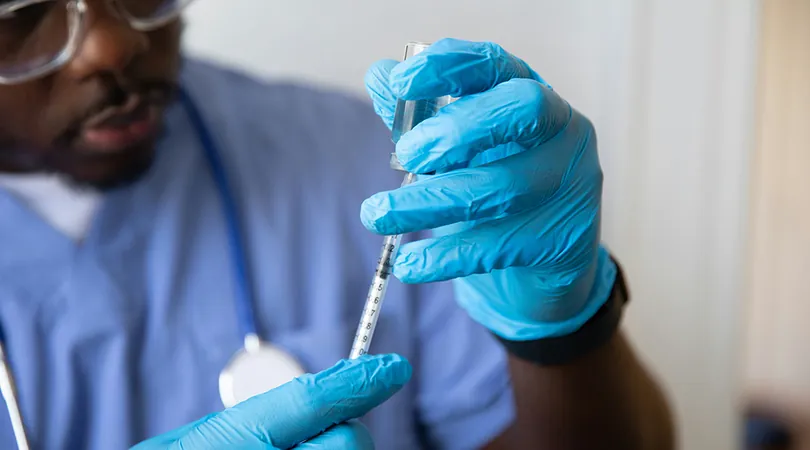
Groundbreaking Technique Promises Safer and More Effective Vaccines!
2024-10-14
Author: Noah
Introduction
In a remarkable advancement for vaccine development, researchers are revolutionizing the design of protein subunit vaccines—those that utilize harmless parts of viruses or bacteria to incite an immune response—by employing a new method that boosts their effectiveness while minimizing reliance on immune-boosting agents known as adjuvants.
Vaccines and Adjuvants
Vaccines traditionally expose the immune system to pathogens, enabling immune cells to swiftly recognize and combat future threats. While modern vaccines often contain adjuvants to amplify immune cell activity, the common adjuvant known as CpG—derived from the DNA of many pathogens but absent in humans—has been associated with severe airway reactions when administered through inhalation.
Innovative Approach
In an innovative approach, researchers have begun directly coupling the protein subunit with CpG oligodeoxynucleotide, drastically reducing the necessary dosage of CpG compared to conventional strategies. This pioneering method, showcased by the team at the Beijing Institute of Biotechnology, could significantly enhance the safety and impact of subunit vaccines such as those targeting HPV and hepatitis B.
Need for Lower Dosage
Li Zhu, a leading researcher, emphasized the critical need to lower CpG adjuvants’ doses in inhaled vaccines to alleviate side effects. This approach is particularly advantageous for respiratory pathogens like influenza and SARS-CoV-2, where the respiratory tract serves as the initial barrier against invasion.
Key Challenge
The key challenge is to ensure that during vaccine administration, both the antigen and adjuvant reach the same immune cells simultaneously. Traditional methods often mix these components separately, which leads to unequal delivery. The researchers’ novel strategy involves linking the antigen with the adjuvant to enhance uptake efficiency.
Enhancing Uptake
Chao Pan, another team member, elaborated that the simultaneous presence of the adjuvant and the antigen can bolster vaccine efficacy while reducing the overall adjuvant dosage, thereby improving safety outcomes. However, crafting the perfect bond requires meticulous control over the linking site's shape and location to prevent hindrance of crucial binding regions, much like ensuring a mold for antibody production is correctly shaped.
Biological Glue
To achieve effective linkage without complex reactions, the team leveraged a “biological glue” called the Spy-Catcher/SpyTag system. This innovative technique allowed for straightforward attachment of the adjuvant and antigen, streamlining the process and ensuring the resulting product is compact enough for cellular entry.
Inspiration from Cancer Treatment
The researchers drew additional inspiration from a cancer treatment designed to elicit immune responses targeting tumor cells. Incorporating a linking protein known as DVC, they successfully connected the CpG adjuvant to the antigen, enhancing the chances of successful immune engagement.
Laboratory Tests
Their laboratory tests confirmed that this antigen-adjuvant complex was formed correctly, significantly lowering the necessary amount of adjuvant while preserving structural integrity—a vital factor for effective immune response.
Next Steps
With a focus on creating a mass production-friendly system, the researchers are now working on aerosolized and powdered forms of the vaccine, experimenting with various dosages and efficiency. “Our next goal is to evaluate dosage forms and prepare for clinical testing in primate models,” Zhu shared. This cutting-edge development could pave the way for safer, more effective inhaled vaccines in the near future, potentially changing the landscape of vaccine administration.
Conclusion
Stay tuned as these researchers aim to bring this groundbreaking vaccine technology to clinical application—an advancement that holds the promise of more efficient public health strategies against viral outbreaks!









 Brasil (PT)
Brasil (PT)
 Canada (EN)
Canada (EN)
 Chile (ES)
Chile (ES)
 España (ES)
España (ES)
 France (FR)
France (FR)
 Hong Kong (EN)
Hong Kong (EN)
 Italia (IT)
Italia (IT)
 日本 (JA)
日本 (JA)
 Magyarország (HU)
Magyarország (HU)
 Norge (NO)
Norge (NO)
 Polska (PL)
Polska (PL)
 Schweiz (DE)
Schweiz (DE)
 Singapore (EN)
Singapore (EN)
 Sverige (SV)
Sverige (SV)
 Suomi (FI)
Suomi (FI)
 Türkiye (TR)
Türkiye (TR)